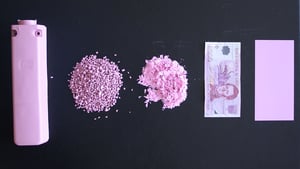The disposal of unfit banknotes doesn’t stop with the destruction and briquetting of the banknotes alone. There is still the remaining waste paper in the briquettes. So what is done with this waste material? There are several preferable and less preferable end destinations for the compacted banknote waste. In this article we look into the recycling of unfit banknotes.
Recycling of banknote shreds
Although the properties of the briquettes largely determine their further use, economic and environmental circumstances definitely play a vital role in the choice of possible applications. Some of the alternatives are:
1) Landfill
Dumping in landfills does not recover any energy and cannot be said to serve any useful purpose whatsoever. More than any other waste form several criteria must be borne in mind when selecting a method for disintegrating currency. These are: security, technical, economical, and environmental issues. The environmental issues with dumping banknote shreds in landfill lead us to recommend avoiding this as a solution.
2) Incineration
As the briquettes have excellent combustion characteristics it will be no problem to discharge them to controlled waste incineration plants. Incineration is widely accepted as a solution in dealing with the increasing amounts of household and industrial waste generated in the world. It is considered to be an environmentally sound solution to the waste problem, provided that the incinerating plant is equipped with flue gas treatment systems, thus protecting the environment against the pollutants generated during combustion of solid waste.
Banknote briquettes can be incinerated at normal temperatures (900 degrees C) and no special high temperature treatment is required. As the combustion value of briquettes is excellent (1,6 x 104 KJ/kg), it may be a favorable additive fuel to balance the poor combustion values of other kinds of waste. The briquettes may also be used as (additional) fuel in industrial furnaces.
3) Fuel for the cement/ceramic industry
All over the world cement is an essential construction element for building houses, offices, plants, roads and bridges. Cement however is not a mineral which can be readily mined, but is a reaction product of a process of burning and heating limestone with a number of additives together in a furnace. The gigantic furnaces used in this process operate at very high temperatures to provoke the requested reaction and therefore ask for large amounts of fuel.
As fuel costs represent a large cost factor in the production process of cement, it is obvious that cement producers are constantly searching for cheap additional fuels for the partial replacement of currently used fossil fuels such as oil, natural gas and brown coal. Various kinds of industrial wastes are in use as alternative fuel and consequently briquettes of granulated used banknotes may take the same place.
Cement factories normally will have to comply with emission regulations and the burning of briquettes will not change that position.
4) Coolant for the steel industry
Worldwide the production of steel commonly is based on the Linz-Donawitz process, named after the steel plants in the homonymous towns where this process was used for the first time. The process is based on blowing pure oxygen into the steel in the melting pot, which generates a large amount of energy and thus produces the so-called oxysteel. In order to cool down this oxysteel various materials must be added to the melt as extra mass with the effect that the excess energy is used for the ignition and burning of the injected materials. As often wood is used for this purpose banknote briquettes could be a good alternative as they are quite comparable to wood.
5) Composting
Finally, another sustainable solution to dispose of the unfit banknote shreds is by composting them. This has been one the methods used by the Bank of England since the early 2000’s after they stopped incinerating the notes in the 1990s. By using it as a soil improver the notes leave little footprint. Read more about the banks approach here.
Polymer banknotes
In recent years, polymer ba nknotes have been added to the cash circulation of many countries. Of course as a plastic type, a whole different range of recycling possibilities apply for these types of notes. Read more on this in our latest article on polymer.
nknotes have been added to the cash circulation of many countries. Of course as a plastic type, a whole different range of recycling possibilities apply for these types of notes. Read more on this in our latest article on polymer.
Are you providing a solution for the recycling of banknotes? Or would you like to find a solution for your banknote shreds? We would gladly hear from you.
You can also check out our page on shred handling or contact one of our experts.
If you would like to stay up to date with the latest insights in unfit currency management, subscribe to this blog at the top of the page for regular updates.
